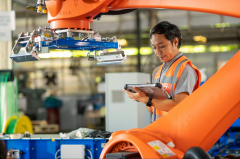Opinions expressed by Entrepreneur contributors are their own.
No longer confined to science fiction or experimental labs, robots are now playing pivotal roles in manufacturing, food service and warehousing. From startups looking to scale quickly to established enterprises seeking efficiency, automation is proving indispensable across sectors. Faced with labor shortages, rising operational costs and increasing demands for efficiency, companies like Amazon, Chipotle and Tesla are turning to automation to fill critical gaps.
These advanced machines — whether humanoid or task-specific — aren’t just supporting workers; they’re reshaping how businesses operate. The question is no longer if robots will be part of the workforce, but how far their influence will extend.
The global labor shortage, intensified by the pandemic and shifting workforce dynamics, has made automation an urgent solution. For startups, which often operate with lean teams, automation offers a way to expand capabilities without significantly increasing headcount. Industries traditionally reliant on manual labor, such as agriculture and food service, are now looking to robots to streamline operations and enhance productivity and safety.
Related: 4 Choices You’ll Make Running Your Startup in the Age of Robots and AI
Robots are taking over
Recent advances in humanoid robots and task-specific automated systems have significantly expanded their capabilities. Even startups in emerging industries are leveraging task-specific robots to gain competitive advantages, such as faster delivery times or streamlined customer service. Tesla’s Optimus robot operates autonomously in factory environments, while Agibot has been deployed for customer service and deliveries. These robots are taking on sophisticated roles, from performing repetitive tasks to enhancing service operations, effectively redefining productivity and efficiency across industries like agriculture, construction and hospitality.
In warehousing, robotic systems have made dramatic strides. Amazon, a pioneer in automation, catalyzed this shift by acquiring Kiva Systems in 2012. Initially, autonomous mobile robots handled tasks in robot-only zones, such as picking and packing. Today, they work alongside human employees, taking on physically demanding and hazardous tasks (like heavy lifting) while improving safety and efficiency.
Agriculture is also undergoing a transformation through robotics. Sensor-based technologies enable robots to manage planting, harvesting and livestock care with precision. By optimizing the use of inputs like fertilizers, these systems reduce environmental impact, enhance biodiversity and improve crop yields, supporting a more sustainable and productive future for farming.
Similarly, the construction industry has embraced robotic solutions. Innovations like Fastbrick Robotics’ Hadrian X, which is capable of laying 300 to 1,000 bricks per hour, drastically reduce the time and labor needed for traditional methods. These advancements address labor shortages while minimizing the physical strain on workers.
In mining, the integration of robotics, artificial intelligence and drones is reshaping site management. Companies like Trimble and Hexagon use drones to create digital twins — 3D models of real-world environments — enabling remote monitoring and real-time decision-making. This enhances safety by reducing human exposure to hazardous conditions and improves overall operational efficiency.
Robots driving change in key industries
The integration of robotics in labor-intensive industries has streamlined operations and improved business outcomes. Sweetgreen, for example, faced high costs and profitability concerns, leading them to acquire robotics startup Spyce and implement “Infinity Kitchens.” These automated systems can produce more than 500 salads per hour, reducing labor needs, cutting overhead and improving accuracy.
This example highlights how automation can help entrepreneurs bridge operational challenges, enabling them to scale without compromising quality or profitability. While full profitability is still a goal, Sweetgreen’s use of automation shows how robots enhance agility and support leaner operations in dynamic markets.
White Castle has embraced automation with Flippy 2, an advanced robot that automates frying, boosting output by 30% and reducing safety risks from hot oil. Instead of replacing workers, Flippy 2 allows employees to focus on customer service, enhancing the overall dining experience.
Related: Walmart’s Using More Robots — But Says They’ll Actually Extend Warehouse Workers’ Careers
These examples from the restaurant industry highlight how robotic systems are tackling labor shortages while elevating opera





